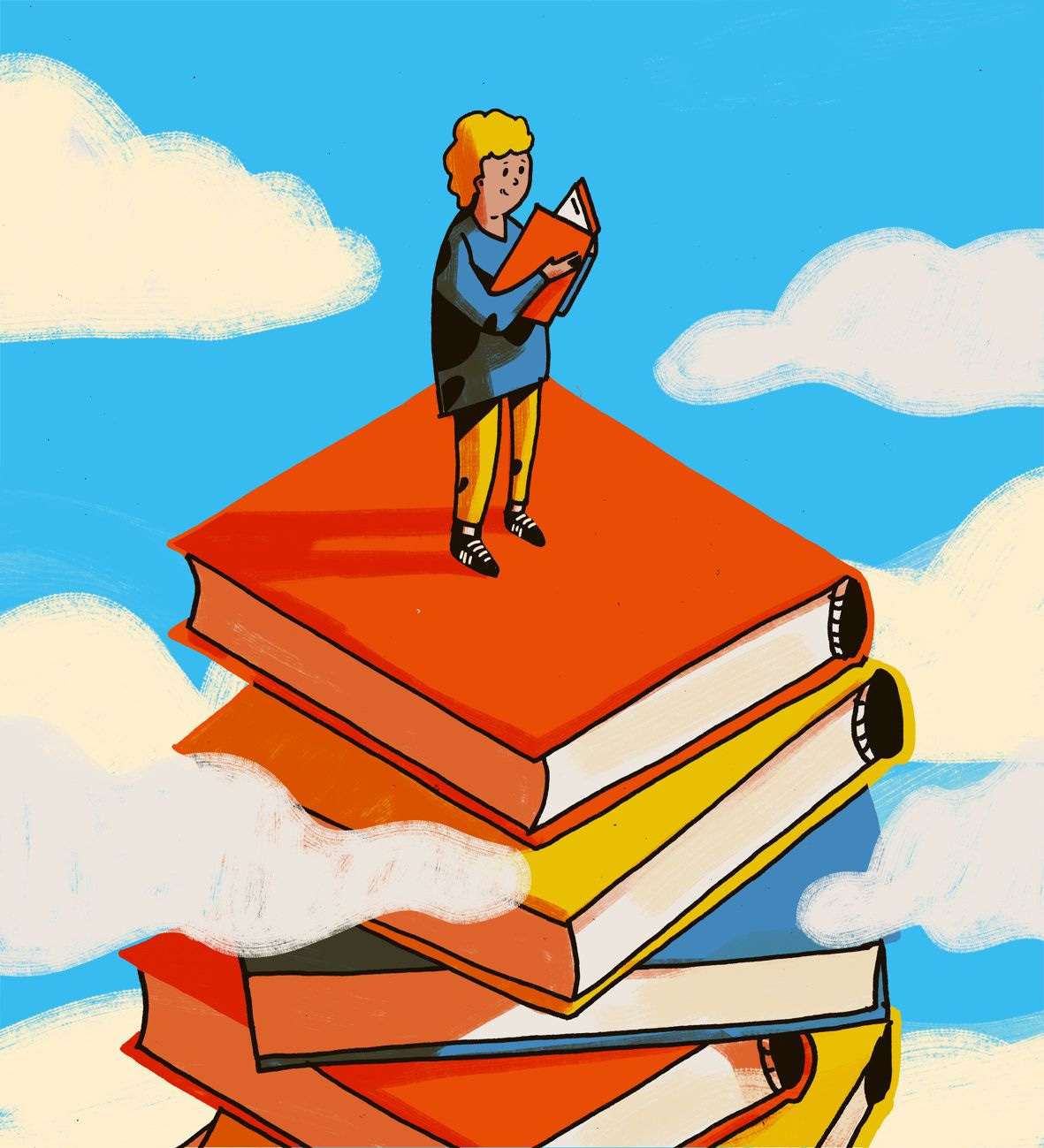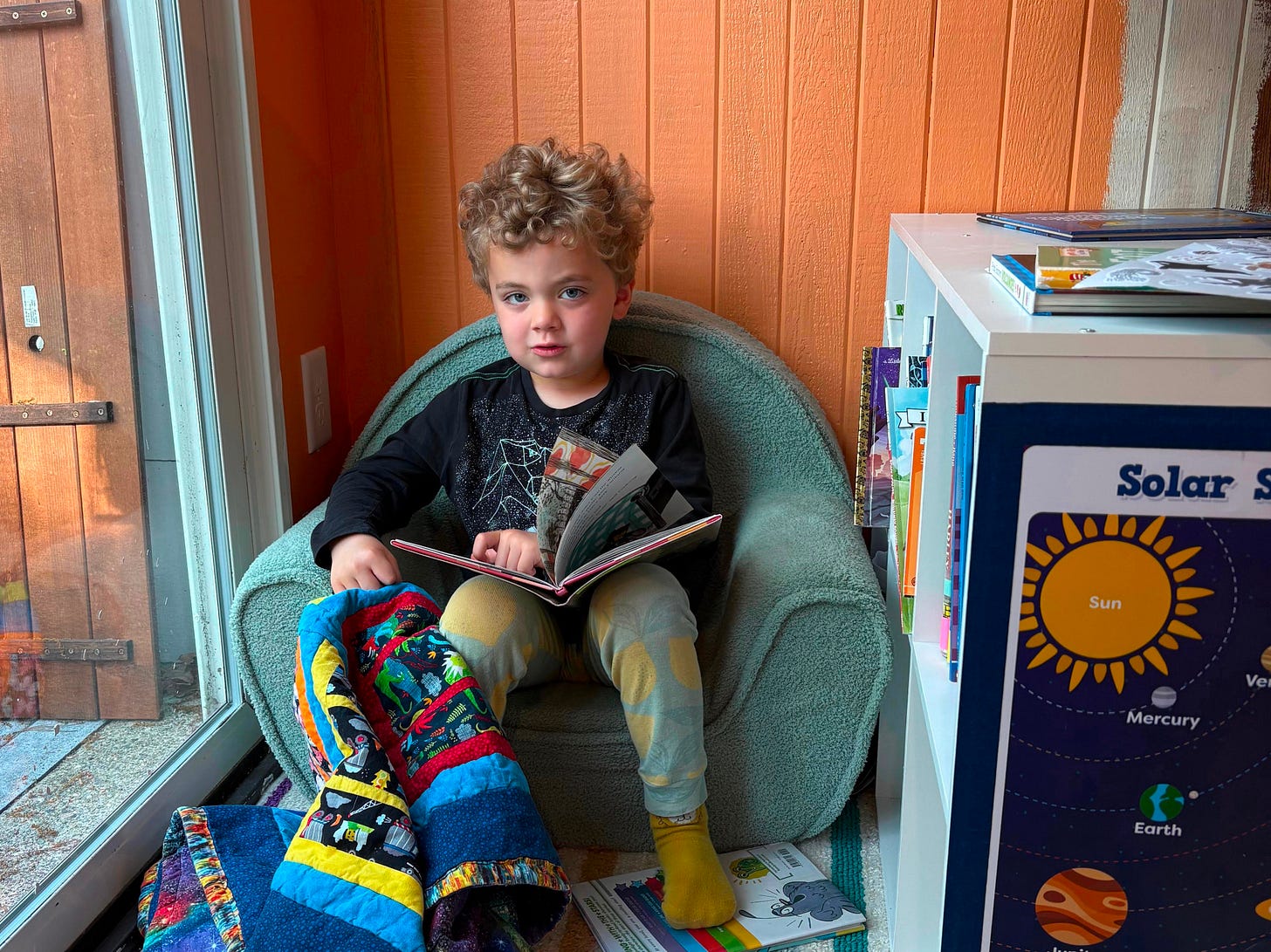
Over a year has passed since I began teaching my toddler—then two years old—how to read (a process chronicled here).
Now, I’m prepared to answer a burning scientific question that has kept absolutely zero researchers up at night: Can a three-year-old read The Hobbit?
Turns out: yeah, pretty much. Here’s Roman reading from Chapter 1:
In a hole, in the ground, there lived a hobbit. Not a nasty, dirty, wet hole, filled with the ends of worms and an oozy smell, nor yet a dry bare, sandy, hole, with nothing in it to sit down on or to eat: it was a hobbit-hole, and that means comfort.
Of course, there are still plenty of words he can’t read! While he could handle a lot of The Hobbit, I haven’t let him read the whole book himself (there’s too much violence, and the small font size, confusing names, and enough unknown words would likely wear him down). But for the class of books that he has any business reading alone, like early readers and chapter books, he can do so. He reads by himself for pleasure every day now, quickly and silently plowing through his growing library, and his decoding abilities have met the limits of his comprehension.
As you can tell, I’m quite proud of how well he’s done, to the degree I risk coming across as supercilious about the whole thing (now there’s a word he probably can’t read). A few months ago, I gave him the SDQA test, a simple way of determining reading level, and he got all the 3rd-grade-level words correct (so somewhere around eight or nine-year-olds).
Estimating reading level isn’t very meaningful from a practical perspective, however. Goodhart’s law of measures becoming targets has made vicious work of education. For example, in a study wherein researchers had college students read the first few paragraphs of Charles Dickens’ Bleak House, only 5% of English majors could passably describe what was going on.
Instead, I think the only literacy milestone worth caring about is whether a child reads for pleasure, because…
Read for pleasure, make brain big.
In the Adolescent Brain and Cognitive Development (ABCD) project, a cohort of over 10,000 children in the US was tracked longitudinally. A 2023 analysis of the data revealed that the earlier a child was reading for pleasure, the more this correlated with higher scores on cognitive tests and lower numbers of mental health issues, even after controlling for things like socio-economic status, such that…
…cognitive performance was better and the mental problems were lower in young adolescents with higher levels of early RfP [reading for pleasure].
Here is years of reading for pleasure plotted against a number of such outcomes.
In fact, the researchers found that reading for pleasure—and the more years spent doing so—may literally lead to larger brain volumes in adolescence.

The positive effects showed up after controlling for genetics (as best one can, using genome-wide analyses in the full cohort). ABCD also had a participating set of 711 twins and, interestingly, estimations from the twin data revealed that, while early reading-for-pleasure does have a genetic component, the majority of the trait’s variance appears environmental.
Put it all together, and early reading for pleasure stands out in the scientific literature, in that it has (a) very broad cognitive benefits, (b) good empirical support for this class of thing, (c) has a large environmental component, and (d) actively replaces and competes with screen time, which is usually neutral or negative in the literature (in the ABCD cohort, screen time had an inverse correlation with reading for pleasure).
This last point, that reading for pleasure fills a certain time in the day, means I daily…
Thank god for this new independent activity.
When I look back on my official reasons for teaching reading so early, oh, how naive I was! All pale in comparison to the true benefit.
Holy smokes, does early reading make parenting easier sometimes!
It’s all the advantages of an iPad, none of the guilt. You’ve unlocked infinite self-entertainment. Long drive? Bring a book. Or five. Roman toddles into restaurants clutching a book as a backup activity, and reads while waiting in boring lines. It’s also calming, and so helps with emotional regulation. Toddler energy descending rapidly into deviance? Go read a book! It’s a parenting cheat code. I don’t know if this alone justifies the hours spent, but it sure is one heck of a benefit.
Here’s a recent picture of him in his natural habitat, in one of his nooks (looking ever less like a toddler and more like a real little kid).
Reading for pleasure was the lodestar that governed my entire teaching process. A lot of other “teach your child to read” methods are based on modular lessons and exercises, which makes learning to read separate from what it’s all about, which is enjoying books. Comparatively, I did it by mostly reading books together, because it turns out reading books is a skill in itself. Not only does this practice the attention span needed to follow through with a book until its end; more subtly, it practices the skills you, a developed adult, don’t ever notice. E.g., sentences in picture-heavy books sometimes start at the top of a page, sometimes at the bottom, sometimes they’re broken up in the middle between images, or are even inside them. So the reader needs to scan for where to start. Easy for you! But much harder for a three-year-old without prior practice. You, an adult, can physically hold books splayed open with different spines and thicknesses, and also you, an adult, can easily flip single paper-thin pages without messing up your spot. But if you’re three? So much of what we do effortlessly is invisible to us. Like how when encountering any new book, there are a few initial pages with tiny text about publishing and copyright. This is the most difficult material, and yet skipping it is not obvious to someone just learning to read. So to get better at reading books, you have to read books!
All in all, this took about one year of tutoring.
In practice, it looked like this (this video spans, from before his 3rd birthday to before his 4th, and concludes about when I deemed we were finished).
The details for anyone who wants to replicate this can be found in a series of guides: Part 1, Part 2, and Part 3, and the last part here. Privately, I’ve already worked with one person who wanted to get his own daughter reading early, and so far has had success, and have heard some success stories from other parents as well. Eventually, I’ll put all these parts together in a book on the science and practice of (very) early reading, with edits and additions and expansions to give more details.
In Part 2, “Getting your child to love reading in 2024,” I discuss how, if the goal is reading for pleasure, then you must have books front and center in terms of daily entertainment. I also discuss the practicalities of setting up a daily “school time” (starting at less than 10 minutes a day, expanding to ~30 minutes a day by the end of the process).
In Part 3, “The BIG GUIDE to teaching LITTLE PEOPLE how to sound out words,” I overviewed how to start and progress with phonics. I also detailed my approach to “blending” sounds, one of the most difficult steps, as well as how to play a “sentence completion game” I developed, which is useful for mastering simple phonics before early readers get introduced.
I took inspiration from my historical research on “aristocratic tutoring,” but I also pulled what’s effective from the science of learning, like how…



